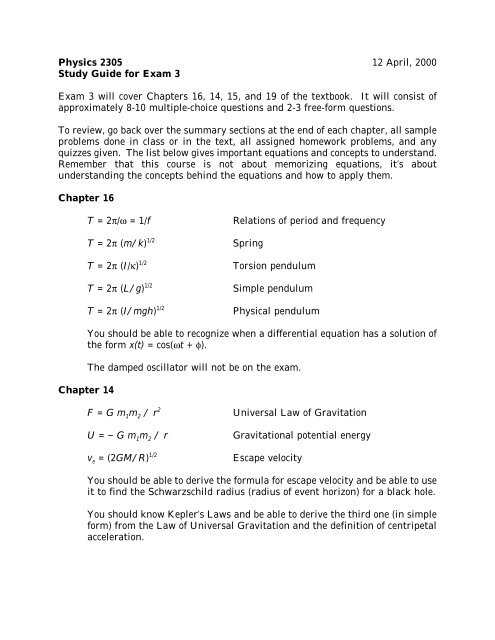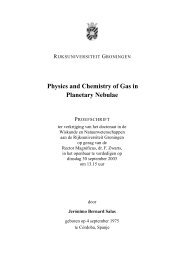Physics 2305 12 April, 2000 Study Guide for Exam 3 Exam 3 will ...
Physics 2305 12 April, 2000 Study Guide for Exam 3 Exam 3 will ...
Physics 2305 12 April, 2000 Study Guide for Exam 3 Exam 3 will ...
You also want an ePaper? Increase the reach of your titles
YUMPU automatically turns print PDFs into web optimized ePapers that Google loves.
<strong>Physics</strong> <strong>2305</strong> <strong>12</strong> <strong>April</strong>, <strong>2000</strong><br />
<strong>Study</strong> <strong>Guide</strong> <strong>for</strong> <strong>Exam</strong> 3<br />
<strong>Exam</strong> 3 <strong>will</strong> cover Chapters 16, 14, 15, and 19 of the textbook. It <strong>will</strong> consist of<br />
approximately 8-10 multiple-choice questions and 2-3 free-<strong>for</strong>m questions.<br />
To review, go back over the summary sections at the end of each chapter, all sample<br />
problems done in class or in the text, all assigned homework problems, and any<br />
quizzes given. The list below gives important equations and concepts to understand.<br />
Remember that this course is not about memorizing equations, it’s about<br />
understanding the concepts behind the equations and how to apply them.<br />
Chapter 16<br />
T =2π/ω =1/f<br />
T =2π (m/k) 1/2<br />
T =2π (I/κ) 1/2<br />
T =2π (L/g) 1/2<br />
T =2π (I/mgh) 1/2<br />
Relations of period and frequency<br />
Spring<br />
Torsion pendulum<br />
Simple pendulum<br />
Physical pendulum<br />
You should be able to recognize when a differential equation has a solution of<br />
the <strong>for</strong>m x(t) = cos(ωt + φ).<br />
Chapter 14<br />
The damped oscillator <strong>will</strong> not be on the exam.<br />
F = Gm 1 m 2 /r 2<br />
U =−Gm 1 m 2 /r<br />
v e =(2GM/R) 1/2<br />
Universal Law of Gravitation<br />
Gravitational potential energy<br />
Escape velocity<br />
You should be able to derive the <strong>for</strong>mula <strong>for</strong> escape velocity and be able to use<br />
it to find the Schwarzschild radius (radius of event horizon) <strong>for</strong> a black hole.<br />
You should know Kepler’s Laws and be able to derive the third one (in simple<br />
<strong>for</strong>m) from the Law of Universal Gravitation and the definition of centripetal<br />
acceleration.
Chapter 14 continued<br />
T 2 =(4π 2 /G) a 3 /(m 1 + m 2 )<br />
Newton’s Form of Kepler’s Third Law<br />
Chapter 15<br />
Satellites and the energy of orbits <strong>will</strong> not be on the exam.<br />
p = F/A<br />
p 2 = p 1 + ρ g ∆y<br />
Pressure and <strong>for</strong>ce<br />
Pressure and depth<br />
You should also know:<br />
- the difference between absolute and gauge pressure<br />
- Pascal’s Principle and its application to the hydraulic lever<br />
F b = ρ d V d g<br />
= weight of displaced fluid<br />
R = Av = ∆V/∆t = constant<br />
p +½ρv 2 + ρgy = constant<br />
Archimedes’ Principle<br />
Equation of Continuity<br />
Bernoulli’s Equation<br />
Chapter 19<br />
T F = (9/5) T C + 32°<br />
∆L = L α∆T<br />
∆V = V β∆T<br />
Q = cm (T f −T i )<br />
Q = Lm<br />
H = Q/t =(A/ΣR) (T H −T C )<br />
R = L/k<br />
P = AεσT 4<br />
Celsius to Fahrenheit conversion<br />
Linear expansion<br />
Volume expansion<br />
Specific heat<br />
Heat of trans<strong>for</strong>mation<br />
Rate of heat flow across a conducting layer<br />
Thermal resistance<br />
Radiated or absorbed power<br />
(T can be <strong>for</strong> the object or its environment)<br />
The discussion about measuring temperature <strong>will</strong> not be on the exam.<br />
That seems like plenty <strong>for</strong> one exam. Good luck preparing!













